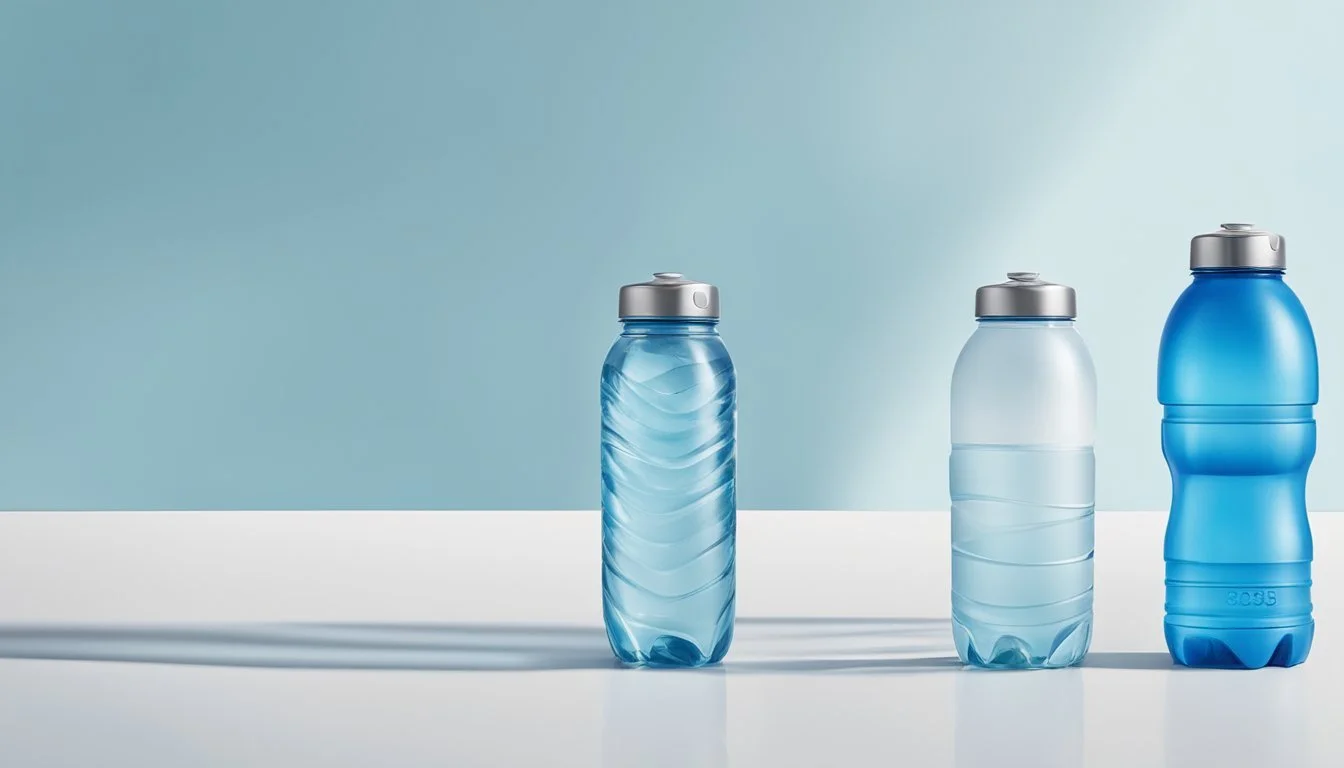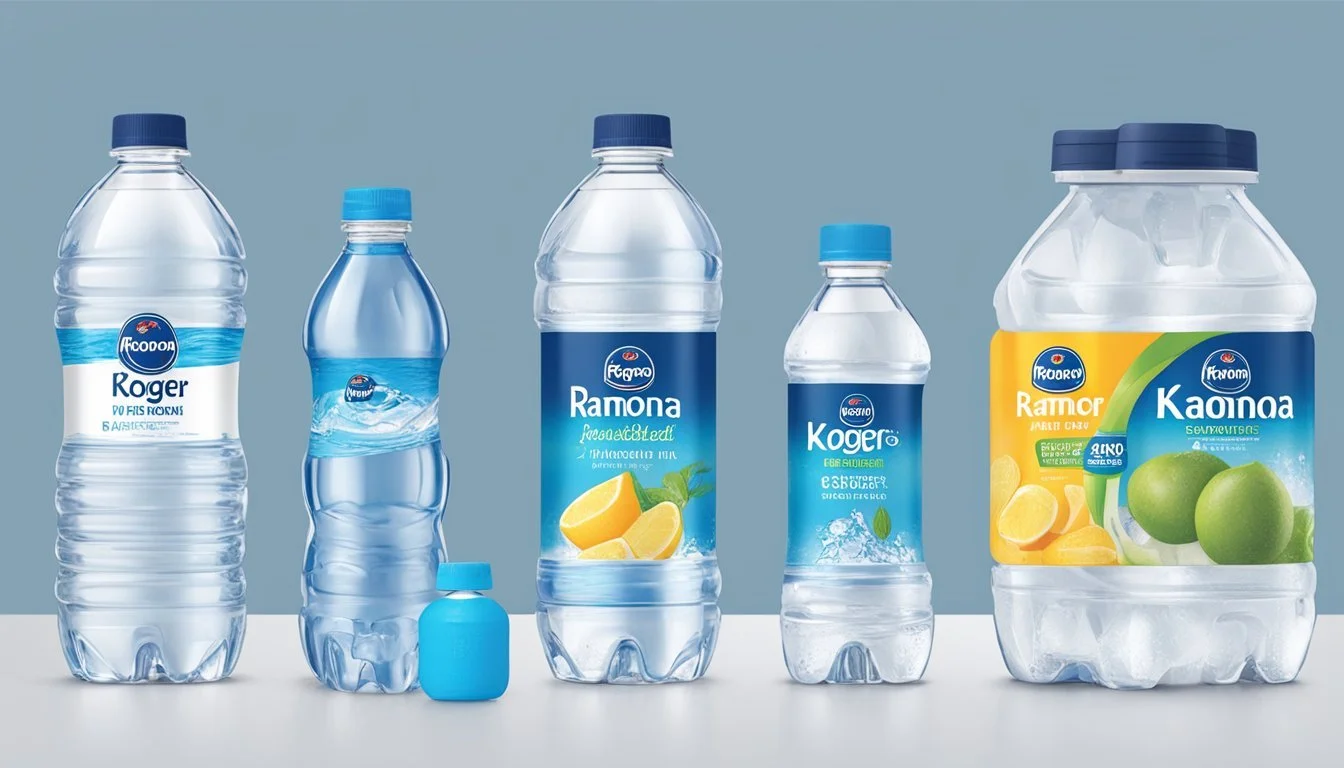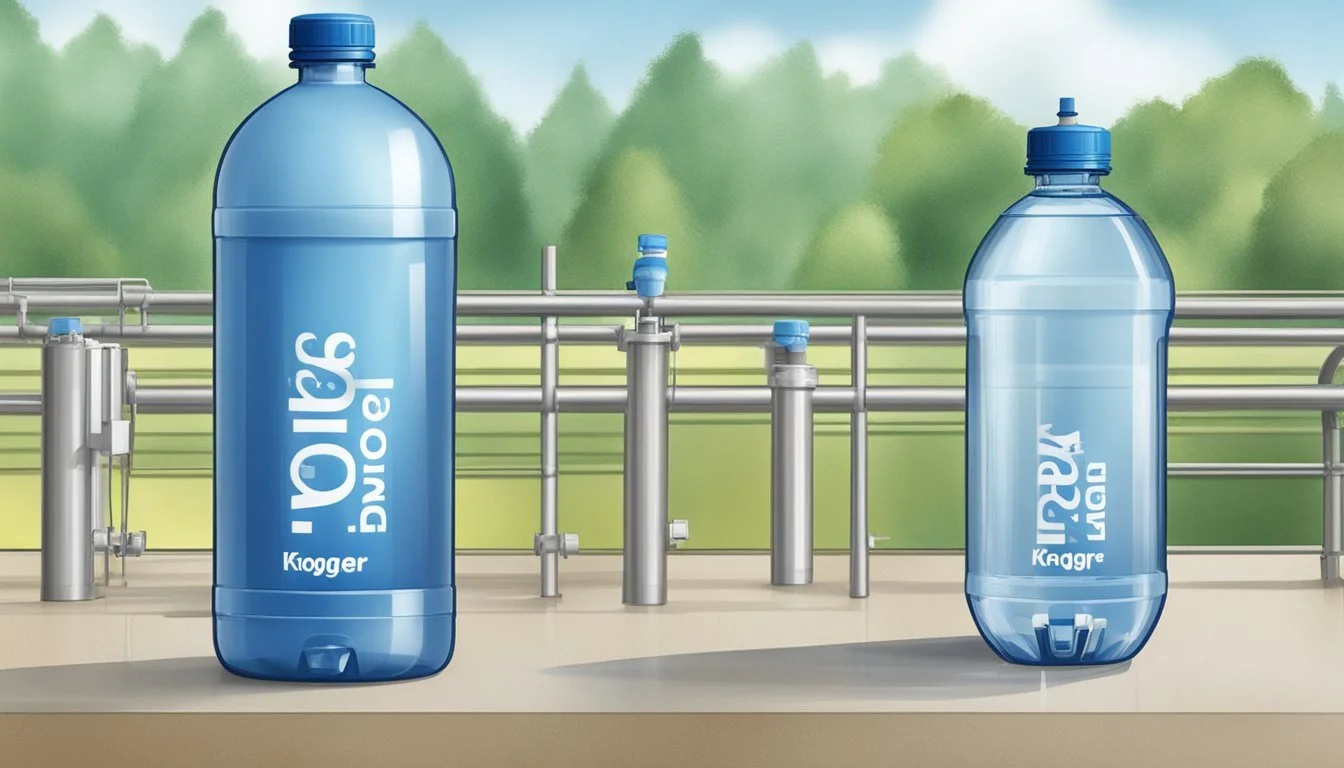Kroger vs. Ramona
Which Bottled Water Reigns Supreme?
Choosing between Kroger and Ramona bottled water can be a subtle yet important decision for consumers seeking the best hydration experience. Kroger offers a budget-friendly option with its crisp spring water available at economical prices, though some users note a slight plasticky taste. Ramona, on the other hand, is recognized as a premium California spring water, which appeals to those looking for purity and a clean taste.
When it comes to safety and quality, Kroger bottled water adheres to FDA regulations, ensuring it meets essential standards, albeit with lingering concerns about microplastics. Ramona, appreciated for its natural source, avoids the plasticky taste some consumers find in Kroger's product, offering a refreshing alternative.
For consumers prioritizing taste and a more premium experience, Ramona may be the better option. Those who need a cost-effective solution without sacrificing basic quality might find Kroger to be a satisfactory choice.
Understanding Bottled Water
Bottled water comes in various forms, each serving a unique purpose and meeting specific consumer needs. The global market for bottled water has evolved considerably, with stringent industry standards ensuring quality and safety.
Definition and Types of Bottled Water
Bottled water is packaged drinking water sold in plastic or glass bottles. It includes several types:
Spring Water: Collected from natural springs, it retains its natural mineral content.
Purified Water: Subjected to purification processes like distillation, deionization, or reverse osmosis, removing impurities.
Natural Spring Water: A form of spring water sourced directly from the underground and bottled at the source without alterations.
Different brands and companies produce a variety of bottled water types to cater to different preferences and needs.
Global Bottled Water Market Overview
The bottled water market has seen significant growth globally. Factors driving this market include:
Consumer Demand: Increased health awareness, convenience, and safety concerns have boosted bottled water consumption.
Key Players: Major companies like Nestlé, Coca-Cola, and PepsiCo dominate the market with brands such as Perrier, Dasani, and Aquafina.
Regional Preferences: Preferences in bottled water types vary, with North America favoring purified water and Europe leaning towards natural spring water.
The market's expansion reflects diverse consumer needs and regional differences.
Bottled Water Industry Standards
Strict regulations govern the bottled water industry. Key standards include:
FDA Regulations: In the United States, the FDA regulates bottled water as a food product, ensuring it meets specific safety and quality standards.
Labeling Requirements: Companies must accurately label their products, including the source and type of water.
Contaminant Limits: Limits on contaminants such as microplastics, BPA, and other pollutants ensure consumer safety.
These standards help maintain the integrity and safety of bottled water, reassuring consumers about product quality.
Health and Safety Considerations
Choosing the right bottled water involves evaluating health impacts and understanding safety standards. Kroger and Ramona, both adhere to strict regulations to ensure quality, though differences in testing and contaminant levels may influence consumer choice.
Health Impact of Water Quality
Water quality directly affects health, especially concerning contaminants like microplastics and BPA.
Kroger bottled water adheres to FDA regulations, which assures certain safety standards. Some bottles are BPA-free, reducing risks related to this chemical.
Ramona water also complies with FDA standards. Attention to microplastic contamination is ongoing, and they may adopt more rigorous filtration practices. Health-wise, both brands attempt to minimize harmful substances, offering consumers relatively safe choices.
Safety and Testing Regulations
Both Kroger and Ramona follow the guidelines set forth by the FDA and the Environmental Protection Agency (EPA).
Kroger’s water is regularly tested, meeting FDA-approved criteria ensuring it’s fit for consumption. They conduct periodic checks to maintain the standards dictated by regulatory bodies.
Ramona water also adheres to stringent safety tests, often implementing advanced filtration methods to uphold EPA and FDA guidelines. Both brands aim to ensure safe drinking water by adhering to rigorous testing protocols.
Lead and Other Contaminants
Lead contamination is a critical concern in drinking water.
Kroger ensures its water sources have low lead levels, complying with EPA’s legal limits. Regular testing helps prevent contamination, maintaining the water’s safety standard.
Ramona employs similar testing measures, frequently checking for lead and other pollutants. They use advanced purification processes to keep contaminants like lead well below dangerous levels. Both brands prioritize consumer safety by minimizing harmful entities through rigorous checks and technologies.
Sourcing and Filtration Processes
When comparing Kroger and Ramona bottled water, it is important to consider where each brand sources its water and the methods they use for filtration and purification. The origin of the water and its processing can significantly influence taste, safety, and environmental impact.
Natural Springs vs. Reverse Osmosis
Natural Springs are a common source for premium bottled water brands. Ramona sources its water from natural springs, which often delivers a crisp, fresh taste directly from the earth's aquifers. This naturally filtered groundwater may contain essential minerals.
Reverse Osmosis, used by Kroger, is a process where water is forced through a semi-permeable membrane to remove impurities and contaminants. While it ensures the water is clean and safe, it may strip minerals that contribute to water’s flavor.
Filtration and Purification Techniques
Ramona relies on multiple filtration stages, including carbon filtration, UV treatment, and ozonation, to maintain the integrity and purity of their spring water. These methods help in removing any residual contaminants while preserving the natural mineral content.
Kroger employs the reverse osmosis process, followed by additional treatments like microfiltration and UV disinfection. This comprehensive purification process ensures that the water is devoid of any harmful substances, making it safe for consumption.
Origin and Environmental Impact
Ramona’s water originates from natural springs located in environmentally protected areas. This sourcing method minimizes contamination but raises questions about long-term environmental sustainability due to resource depletion and ecological impact. The production and transport of spring water can lead to a higher carbon footprint.
Kroger, sourcing water from municipal systems before rigorous filtration, focuses on accessibility and sustainability. They aim to mitigate environmental impacts by using BPA-free bottles and actively promoting recycling. The reverse osmosis method allows utilization of local water sources, potentially reducing the resource strain seen with spring water extraction.
Both brands highlight efforts to be environmentally friendly. Ramona’s allure lies in the purity of natural springs, while Kroger emphasizes widespread availability and comprehensive purification methods. The choice may ultimately depend on the consumer’s preference for taste, origin transparency, and commitment to sustainability.
Comparing Kroger and Ramona Water
Both Kroger and Ramona bottled waters cater to different consumer preferences, offering distinct taste profiles and packaging options. The following analysis will delve into their taste and pH levels, environmental responsibility, and price point.
Taste and pH Level Analysis
Kroger bottled water is known for its crispness. Some reviews point out a faint plasticky taste, which might be due to the bottled packaging. Its pH level falls in the neutral range, suitable for daily consumption.
Ramona, sourced from California springs, typically offers a fresher taste. Consumers appreciate its lack of aftertaste. Ramona water often has a slightly alkaline pH, providing a smoother drinking experience.
Taste and pH Comparison:
Brand Taste pH Level Kroger Crisp, slight plasticky taste Neutral Ramona Fresh, no aftertaste Slightly Alkaline
Packaging and Environmental Responsibility
Kroger's use of plastic bottles raises concerns about environmental impact. Although many of their bottles are BPA-free, plastic waste remains an issue.
Ramona, on the other hand, offers an edge with its environmentally friendly packaging. Many Ramona bottles are available in glass, reducing plastic use and waste. Glass bottles are reusable and recyclable, aligning better with sustainability goals.
Packaging and Environmental Responsibility Comparison:
Kroger:
Material: Plastic (BPA-free in many cases)
Environmental Impact: Higher due to plastic use
Ramona:
Material: Glass bottles
Environmental Impact: Lower, more sustainable
Price Point and Consumer Accessibility
Kroger’s bottled water is competitively priced at around $1.29 per gallon. This affordability makes it a convenient choice for budget-conscious shoppers.
Ramona, being a premium spring water, comes at a higher price point. Its cost reflects the quality and sustainability of its packaging. This might make it less accessible for some consumers.
Price Point and Consumer Accessibility Comparison:
Brand Price (per gallon) Consumer Accessibility Kroger $1.29 Budget-friendly, widely available Ramona Higher Premium pricing, selective availability
Consumer Perspectives and Brand Reputation
When comparing Kroger and Ramona bottled water, examining consumer reviews, water sommelier insights, and market presence reveals valuable insights into their standings.
Customer Reviews and Preferences
Kroger: Many consumers appreciate the accessibility and affordability of Kroger bottled water. However, reviews reveal mixed reactions regarding taste and quality. Some find it refreshing and clean, while others note a slight plastic aftertaste.
Ramona: Ramona bottled water generally receives high praise for its crisp and natural taste. Customers often commend its purity and refreshing quality. A recurring theme in reviews is its reliable and consistently good flavor, positioning it as a preferred choice for those seeking premium water.
Water Sommelier Insights
Water sommeliers often emphasize the importance of source and mineral content. Kroger water, adhering to FDA regulations, might not stand out in this niche field due to the presence of microplastics in some cases. Conversely, Ramona's water, sourced from reputed springs, usually garners positive feedback from sommeliers. They highlight its balanced mineral composition and mouthfeel, elements connoisseurs value deeply.
Market Presence and Loyalty
Kroger: Kroger's expansive distribution network and competitive pricing ensure strong market presence. The brand enjoys substantial loyalty among consumers seeking budget-friendly options. Regular shoppers appreciate the convenience of purchasing Kroger water during their routine grocery trips.
Ramona: Ramona, though less prevalent in every supermarket, sustains a loyal following due to its high-quality offering. People often associate it with reliability and premium quality. This brand loyalty is particularly strong among consumers who prioritize taste and purity, even if it means a higher price point.
Bold distinctions in customer preferences and professional evaluations illustrate the differing appeals of Kroger and Ramona bottled water.
Scientific Analysis and Expert Opinions
To provide a thorough comparison between Kroger and Ramona bottled waters, we examine their chemical and mineral composition as well as insights from health experts and nutritionists.
Chemical and Mineral Content Analysis
Scientists analyze bottled water compositions to determine the presence of minerals and any potential contaminants. Kroger bottled water undergoes rigorous treatments like reverse osmosis and filtration processes.
This ensures it meets FDA regulations for safety and quality.
Mineral content in Kroger water includes essential elements like calcium and magnesium, but the content might vary across batches.
Ramona bottled water also adheres to similar stringent processes. Its mineral composition is reported to be consistent, with minimal to no detectable contaminants. Recent studies have indicated that Ramona water maintains a balanced mineral profile, suitable for daily consumption.
Both brands aim to minimize heavy metals and other unwanted substances, ensuring their products are safe for consumers.
Health Expert and Nutritionist Contributions
Health experts and nutritionists contribute to the discussion by assessing the nutritional value and potential health impacts of different bottled water brands.
Kroger bottled water has been recognized for its safety and low contaminant levels. Experts emphasize its compliance with safety standards but also note concerns about microplastics and previously present BPA, although many bottles now are BPA-free.
Nutritionists often favor Ramona for its consistent mineral content and fewer chemical additives. Ramona water is praised for its natural mineral balance which contributes to hydration and overall health. The treatment processes used are effective in removing harmful substances while retaining beneficial minerals.
For those concerned with heavy metal exposure, both brands provide regular quality reports to reassure consumers.
The Future of Bottled Water
The bottled water industry is rapidly evolving with advances in production techniques and stricter regulatory changes aimed at addressing environmental concerns. This section delves into the most crucial aspects shaping the future of bottled water.
Innovations in Bottled Water Production
Bottled water companies are investing heavily in innovative production methods to improve quality and sustainability. Techniques such as advanced filtration systems and mineral-enhancement processes are gaining traction.
Smart packaging is another innovation, featuring markers that monitor freshness and consumption. This technology helps consumers keep track of their water intake, promoting healthier hydration habits.
Eco-friendly packaging is a priority, with companies like PepsiCo and Coca-Cola introducing plant-based bottles and biodegradable materials. The focus is on reducing plastic waste and environmental pollution. These advancements are not just limited to large corporations; even smaller brands are adopting sustainable practices to meet consumer demand for greener options.
Regulatory and Environmental Changes
Stricter regulations are being implemented by the FDA and the EPA, focusing on the safety and environmental impact of bottled water. These regulations aim to reduce contaminants and improve water quality.
Environmental policies are also evolving. The International Bottled Water Association (IBWA) has been advocating for more rigorous standards and better recycling practices. Governments worldwide are considering bans on single-use plastics, pushing companies to explore alternative materials.
Sustainability is a key concern, with a shift towards carbon-neutral production processes. Companies are also required to provide transparent information about their water sources and production methods, ensuring consumer trust.
These combined efforts are shaping a more sustainable and responsible future for the bottled water industry.
The Bottom Line
When comparing Kroger and Ramona bottled water, several factors come into play. Quality is paramount, and both brands adhere to safety and quality standards.
Taste is subjective. Kroger often has a clean, neutral taste, while Ramona offers a crisp, refreshing flavor. This could be a deciding factor for many consumers.
Price differences are notable. Kroger tends to be more affordable, making it accessible for budget-conscious buyers. Ramona, while potentially pricier, may justify the difference through its perceived superior taste and packaging.
On sustainability, Ramona stands out. With a focus on eco-friendly packaging, it appeals to environmentally conscious consumers. Kroger's efforts are notable, but more can be done to minimize their environmental impact.
Both brands cater to different market segments. Kroger excels in accessibility and affordability, while Ramona appeals to those prioritizing taste and sustainability.
Comparing to Core and Essentia, Kroger and Ramona offer good options within their respective niches. Core and Essentia are premium options with specific health-focused benefits, often at a higher price point.
In summary, when choosing between Kroger and Ramona, consider what factors matter most: taste, price, or sustainability. Each brand offers unique advantages, catering to diverse consumer needs.
More About Kroger
Kroger vs Kirkland Signature: Which Bottled Water is Better?
Kroger vs Richard's Rainwater: Which Bottled Water is Better?
Mountain Valley Spring Water vs Kroger: Which Bottled Water is Better?
Whole Foods Italian Still Mineral water vs Kroger: Which Bottled Water is Better?








